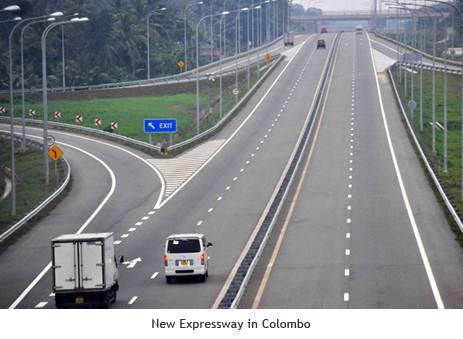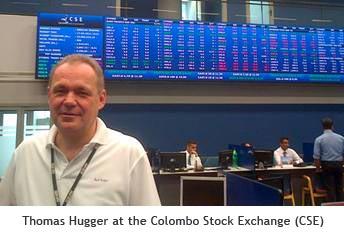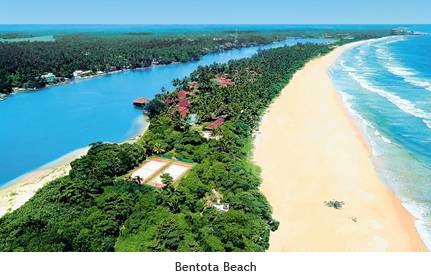In line with AFC's process of being on the ground in the countries we invest in, AFC's CEO & Fund Manager, Thomas Hugger, travelled to Sri Lanka to conduct company visits and meet with investors in Colombo.
I have always found travelling to Sri Lanka to be one of the more fascinating international destinations and can see why tourism has been such a booming industry in a country that was only recently in the midst of a civil war. We flew into Colombo Bandanaraike International Airport which began its life as a British military airbase during WWII. Colombo International Airport has seen some upgrades since then and now has 8 aero-bridges which were opened in November 2005. Otherwise the rest of the airport remains basically the same since my wife and I first visited Sri Lanka on our Christmas holiday in 1985. The trip itself was very pleasant but the circumstances facing the country at the time made it bittersweet as this was during the height of the civil war which started on 23rd July 1983 and lasted for 26 years until it ended in May 2009.
The only other international airport, Hambantota, is located in the southern region of Sri Lanka where the current President of Sri Lanka, Mahinda Rajapaksa's, has his origins. It started operating on 18th March 2013 after investments in the amount of USD 210 million were made and currently only Sri Lankan Airlines and Fly Dubai are using the southern airport for regular international scheduled flights.
At the immigration counters our passports and visas were checked by a smiling all female staff wearing the traditional saree dress in stark contrast at departure a few days later when we were checked by unmotivated all male immigration staff. We then proceeded towards the luggage hall, passing by dozens of duty free shops almost all of them selling washing machines, ovens, cookers and other household equipment and white goods. Apparently Sri Lankan nationals returning after an overseas trip benefit from tax reduction when buying these goods at the airport. We received our luggage within a few minutes and after clearing the customs we were greeted by our hotel representative who guided us the short walk to the hotel car waiting for us outside of the terminal building.
In the past, the 35 km trip from the airport to the hotels in the city centre through small suburban villages would take anything between 1 to 2 hours depending on the time of the day. This time our driver navigated the car through the bustling arrival area and after a 2 minute drive we were on the brand new 25.8 kilometre long Katunayake Expressway linking Negombo and the airport with Colombo. The highway was opened on 27th October 2013 and is the nation's second highway. The toll is 300 Rupees (USD 2.30) and we reached the end of the highway in less than 20 minutes. The E03 has two lanes in each direction built to the standard of the German Autobahn after an investment of approximately USD 300 million most of which is funded by the Exim Bank of China. The majority of the new infrastructure spending like ports, highways, hydroelectric power stations and railway lines is funded by China.

When exiting the highway and driving through the more established roads we noticed two major changes compared with our previous five visits to Colombo: The buildings, roads and public areas were in much better condition and everything in view was cleaner. We were told by our driver that the defence ministry had previously deployed soldiers as a means of tidying up the city. The military presence was formally one of the biggest nuisances when visiting Sri Lanka in the past where road blocks and checks were set up roughly every 1 kilometre in the city and every 5 to 10 kilometres in the countryside. This is a thing of the past and during our one week long stay we did not come across a single checkpoint on the road. The situation was the same in front of our hotel and other major buildings where the security presence has been significantly relaxed. This is a big step and a very positive sign for the country's growing tourism industry which saw tourist arrivals increase by 27% in 2013 to 1.3 million.
We spent the first two nights at the Cinnamon Lakeside Hotel which has an idyllic location at the Beira Lake in the middle of Colombo. The purpose of my visit was to attend a 3 day investment seminar organized by Seraph (www.seraph.vc) where I was given the opportunity to present Asia Frontier Capital and our funds to accredited investors from the US, Asia and Europe. The first part of the seminar was held in Colombo where we also visited the Colombo Stock Exchange "CSE" and the Securities and Exchange Commission. The "CSE" is located in one of the two World Trade Center Towers which are currently the tallest buildings in Colombo. This will certainly change over the next couple of years as there are several high rise buildings in construction or in planning. Major hotel chains like Hyatt and Shangri-La have also started constructing new hotels near the beautiful sea front promenade or Galle Road. These new buildings and the two new planned casinos - one of them the Crown Casino by Australian casino king James Packer - will definitely change the still colonial looking city centre of Colombo in the future.

The second and third days of the seminar were held in the Bentota Beach Hotel in the southern part of Sri Lanka approximately a two hour drive from Colombo. Despite a newly built 128 km long Southern Expressway Colombo-Matara "E01" the drivers decided to take us to Bentota using the old main road "A2" along the coast and passed through several towns which my wife Manuela and I knew from our previous five visits to Bentota. It was interesting to see the small changes on the way. As expected the traffic was heavier, the cars newer (mainly Japanese and Korean cars) and some parts of the road were upgraded from two lanes to four. Also the buildings along the road were renovated to be cleaner and neater to look at than a couple of year ago. The small seaside resort of Bentota is about 8km south of Beruwala in the Galle district and hosts about 50 smaller hotels but also more luxurious hotels such as the Taj Bentota Hotel from the prestigious Indian Taj hotel chain or boutique hotels like Saman Villas.

Most of these hotels have been renovated or newly build after the 26th December 2004 Tsunami which had also hit Sri Lanka and killed 30,196 people including a number of foreign tourists in Bentota. The main attraction is the beach which is several kilometres long and provides good surfing during high tide. At the seminar organized by Seraph interesting investment proposals were presented and there were some interesting offerings: a spice farm in Cambodia, hydro power generation in Nepal, a graphite mine in Sri Lanka, a coconut drink sourced in Sri Lanka and marketed in the US, a pre-IPO fund and a fund investing in cryptocurrencies and cryptopayment systems. Seraph operates like a club where the members can decide to co-invest alongside the promoters Chris and Marc.
The last three days of our stay in Sri Lanka were used to visit Asia Frontier Capital's brokers and meet with companies' that the AFC Asia Frontier Fund has an interest in. On Thursday morning we drove back from Bentota to Colombo, this time using the newly built Southern Expressway. To my surprise I had to tell the driver to use the Expressway several times which he finally did after I told him that I was willing to pay additional 500 Rupees. This toll-highway was opened on 27th November 2011 and has four lanes comparable to a German Autobahn. Most of the highway is elevated in order to avoid flooding during tropical rains or monsoon period. However there was hardly any traffic on the highway and according to statistics only 9,000 vehicles used the expressway on average per day in 2012. The exit to Colombo is still 20 kilometres away from the city centre so we still had to navigate quite a bit of city traffic upon exiting the highway.
My first company visit in Colombo was to the local subsidiary of a US oil major which produces and distributes lubricants - mainly for vehicles and heavy engines used in thermal power stations. The company is facing sales volume decline due to the government policy to phase out polluting thermal power and replace it with more environmental friendly hydro, wind and solar power. Additionally the increased replacement of old cars with new cars that use fewer lubricants combined with the entrance of new competitors is going to put pressure on sales. The only upside I see for this company is a possible future distribution of their products in Bangladesh or India. The company is still paying almost all of its profits to its shareholders in form of a cash dividend - as with most other international subsidiaries - and has a dividend yield of 6.8%. Despite this I was glad that I sold the fund's shares in May last year with a nice profit at 316 Rupees (share price today 266).
My next company visit took me to one of our portfolio's favourite holding's which is also one of Sri Lanka's leading construction companies. We first met this company during the "Sri Lanka Investor Day" in Hong Kong in September 2013 when we had the chance to interact with the Chairman. We wrote about this experience in our September 2013 newsletter which is available via this link. This time I was able to meet with the CEO - which is a privilege most boutique fund managers rarely experience in developed markets when running a niche fund as I currently do - and our positive view on the company was confirmed by our meeting which continued for over one hour. We will certainly increase our exposure in the company in the future and since my visit the fund has already taken new positions.
My next visit was another company my analyst Ruchir "discovered" recently and we have never met before. Before buying a new stock we normally try to see the management of the company first or at minimum conduct a conference call with the company or research analysts we respect. It is a small diversified conglomerate established in 1948 as a distributor for pharmaceutical products. Over the time the group has added several other divisions. However the second largest division today is "FMCG" (fast moving consumer goods), a sector we generally like to invest in. I met with the CFO and I was able to receive detailed information about financials, strategy of the group and outlook. This meeting confirmed our positive view and it would not be surprising to see value unlocking from the balance sheet of this company at some point in time since the current holding structure format of the company leads to a discount in valuations relative to the market/peers.
My next meeting was with a conglomerate of tile companies which was arranged by our friendly Sri Lankan brokers whom I have known personally for over 20 years. We have invested in two tile companies in Sri Lanka expecting that these two companies should benefit from higher infrastructure spending and high GDP growth. To our surprise one of these companies took over the other in May last year. When I met with the CEO (of the acquired company) he explained the current situation of the take-over on the company's business outlook. The CEO was exceptionally honest about the merger integration and outlook so our analyst Ruchir and myself need to dig a little deeper into these stocks to decide about our future strategy in this sector.
The most difficult meeting to arrange was with the company we currently have as our largest investment holding in Sri Lanka - an automobile distributor. The company normally does not meet with investors and only thanks to the excellent connections of our broker with the CEO were we able to get a meeting with the company's CFO. He briefed us in detail about the company's financial performance and outlook but also about the future developments like new products and brands. It was a very helpful and informative meeting. However like in the past meetings I heard again that the consumer sentiment currently in Sri Lanka was not the euphoric whirlwind which could be assumed when simply looking at the available economic figures.
My last meeting was with a cement company which I already met last year in Hong Kong during the same "Sri Lanka Investor Day". I was informed about the latest developments and future outlook of their markets and the outlook for this company was very optimistic - similarly to the construction company I had visited earlier. Since the end of the war, the Sri Lankan government has been spending a great deal on infrastructure development and it is therefore not surprising to hear optimistic outlooks from construction related companies. This information received will help us to update our internal financial models which Ruchir has been building and fine tuning over the past several months. These meetings were extremely helpful in making an up to date and duly informed decision about our current and possible future investments in Sri Lanka.